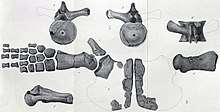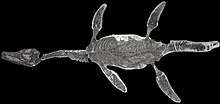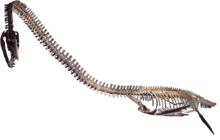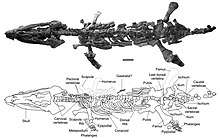Mauisaurus
Mauisaurus ("Māui lizard") is a genus of plesiosaur that lived during the Late Cretaceous period around 77 million years ago in what is now New Zealand. It was the largest plesiosaur, and perhaps the largest marine reptile in New Zealand waters at the time. Numerous specimens have been attributed to this genus in the past, but a 2017 paper restricts Mauisaurus to the lectotype and declares it dubious.[1]
| Mauisaurus | |
|---|---|
 | |
| Holotype | |
| Scientific classification | |
| Kingdom: | Animalia |
| Phylum: | Chordata |
| Class: | Reptilia |
| Superorder: | †Sauropterygia |
| Order: | †Plesiosauria |
| Family: | †Elasmosauridae |
| Genus: | †Mauisaurus Hector, 1874 |
| Species: | †M. haasti |
| Binomial name | |
| †Mauisaurus haasti Hector, 1874 | |
Description

At 68 cervical vertebrae, Mauisaurus is notable for having one of the longest necks (in terms of vertebra number) of any plesiosaur. Mauisaurus was fairly large, reaching over 8 metres (26 ft) in length.[2][3] Like other plesiosaurs, it had a long slender body, with numerous vertebrae, allowing flexible movement. On its underside, Mauisaurus had two sets of large flippers. These aided in swimming at high speeds, but may have also allowed the plesiosaur to venture onto shorelines for short amounts of time. Mauisaurus was a carnivore, with sharp jagged teeth that would have been used to grip fish or squid.
History of discovery
Mauisaurus remains have all been found in New Zealand's South Island, near Canterbury. One Mauisaurus fossil was even found battling a mosasaur from the New Zealand region. Mauisaurus gardneri was described in 1877 based on cervical vertebrae and a humerus from the Gault Clay of Folkestone, but was later declared a nomen vanum in an overview of Cretaceous plesiosaurs published by Samuel Welles in 1962.[4]
Mauisaurus gets its name from the New Zealand Māori mythological demigod, Māui. Māui is said to have pulled New Zealand up from the seabed using a fish hook, thus creating the country. Thus, Mauisaurus means "Māui lizard". Mauisaurus gets its scientific last name from its original finder, Julius von Haast, who found the first Mauisaurus fossil in 1870. The specimen was then first described in 1874.
Cultural references
Mauisaurus is one of the few New Zealand prehistoric creatures, and so, has had much publicity in the country. On 1 October 1993, a set of stamps was released to the general public. Although it depicted many other dinosaurs and prehistoric life, Mauisaurus was featured hunting fish on the $1.20 stamp[5].
References
- Norton Hiller; José P. O’Gorman; Rodrigo A. Otero; Al A. Mannering (2017). "A reappraisal of the Late Cretaceous Weddellian plesiosaur genus Mauisaurus Hector, 1874". New Zealand Journal of Geology and Geophysics. 60 (2): 112–128. doi:10.1080/00288306.2017.1281317.
- Hiller, N., Mannering, A.A., Jones, C.M., Cruickshank, A.R.I. (2005). The nature of Mauisaurus haasti Hector, 1874 (Reptilia: Plesiosauria). Journal of Vertebrate Paleontology 25 (3):588-601.
- O'Gorman, J.P. (2016). "A Small Body Sized Non-Aristonectine Elasmosaurid (Sauropterygia, Plesiosauria) from the Late Cretaceous of Patagonia with Comments on the Relationships of the Patagonian and Antarctic Elasmosaurids". Ameghiniana. 53 (3): 245–268. doi:10.5710/AMGH.29.11.2015.2928.
- Welles, S. P. 1962. A new species of elasmosaur from the Aptian of Columbia and a review of the Cretaceous plesiosaurs. University of California Publications in Geological Science 46, 96 pp.
- "Dinosaurs". New Zealand Post Stamps. Retrieved 2018-12-20.




